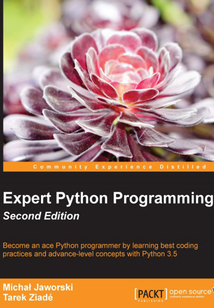目錄(105章)
倒序
- coverpage
- Expert Python Programming Second Edition
- Credits
- About the Authors
- About the Reviewer
- www.PacktPub.com
- eBooks discount offers and more
- Preface
- What this book covers
- What you need for this book
- Who this book is for
- Conventions
- Reader feedback
- Customer support
- Chapter 1. Current Status of Python
- Where are we now and where we are going?
- Why and how does Python change?
- Getting up to date with changes – PEP documents
- Python 3 adoption at the time of writing this book
- The main differences between Python 3 and Python 2
- Not only CPython
- Modern approaches to Python development
- Application-level isolation of Python environments
- System-level environment isolation
- Popular productivity tools
- Useful resources
- Summary
- Chapter 2. Syntax Best Practices – below the Class Level
- Python's built-in types
- Advanced syntax
- Other syntax elements you may not know yet
- Summary
- Chapter 3. Syntax Best Practices – above the Class Level
- Subclassing built-in types
- Accessing methods from superclasses
- Advanced attribute access patterns
- Metaprogramming
- Summary
- Chapter 4. Choosing Good Names
- PEP 8 and naming best practices
- Naming styles
- The naming guide
- Best practices for arguments
- Class names
- Module and package names
- Useful tools
- Summary
- Chapter 5. Writing a Package
- Creating a package
- Namespace packages
- Uploading a package
- Standalone executables
- Summary
- Chapter 6. Deploying Code
- The Twelve-Factor App
- Deployment automation using Fabric
- Your own package index or index mirror
- Common conventions and practices
- Code instrumentation and monitoring
- Summary
- Chapter 7. Python Extensions in Other Languages
- Different language means – C or C++
- Why you might want to use extensions
- Writing extensions
- Challenges
- Interfacing with dynamic libraries without extensions
- Summary
- Chapter 8. Managing Code
- Version control systems
- Continuous development processes
- Summary
- Chapter 9. Documenting Your Project
- The seven rules of technical writing
- A reStructuredText primer
- Building the documentation
- Making your own portfolio
- Summary
- Chapter 10. Test-Driven Development
- I don't test
- I do test
- Summary
- Chapter 11. Optimization – General Principles and Profiling Techniques
- The three rules of optimization
- Optimization strategy
- Finding bottlenecks
- Summary
- Chapter 12. Optimization – Some Powerful Techniques
- Reducing the complexity
- Simplifying
- Using collections
- Using architectural trade-offs
- Caching
- Summary
- Chapter 13. Concurrency
- Why concurrency?
- Multithreading
- Multiprocessing
- Asynchronous programming
- Summary
- Chapter 14. Useful Design Patterns
- Creational patterns
- Structural patterns
- Behavioral patterns
- Summary
- Index 更新時間:2021-07-16 10:58:24
推薦閱讀
- 流量的秘密:Google Analytics網站分析與優化技巧(第2版)
- 實用防銹油配方與制備200例
- The React Workshop
- Mastering Unity Shaders and Effects
- 用Flutter極速構建原生應用
- JAVA程序設計實驗教程
- Building Machine Learning Systems with Python(Second Edition)
- Python網絡爬蟲技術與應用
- INSTANT Apache Hive Essentials How-to
- Processing開發實戰
- Neo4j Graph Data Modeling
- TensorFlow+Keras深度學習算法原理與編程實戰
- .NET應用架構設計:原則、模式與實踐
- Swift語言實戰晉級(第2版)
- 換個姿勢學C語言
- iOS Application Development with OpenCV 3
- 面向對象技術與工具(第2版)
- Kivy Blueprints
- Learning OpenCV 4 Computer Vision with Python 3
- Building Data Streaming Applications with Apache Kafka
- JavaScript Promises Essentials
- PhoneGap Essentials
- 明解Python
- C教程
- Scratch趣味編程:孩子的第一本編程啟蒙書
- Apache Spark 2:Data Processing and Real-Time Analytics
- CimatronE 10.0三維設計與數控編程基本功特訓
- 重構與模式(修訂版)
- 愛上編程:給孩子的編程入門書
- Storm實時數據處理


